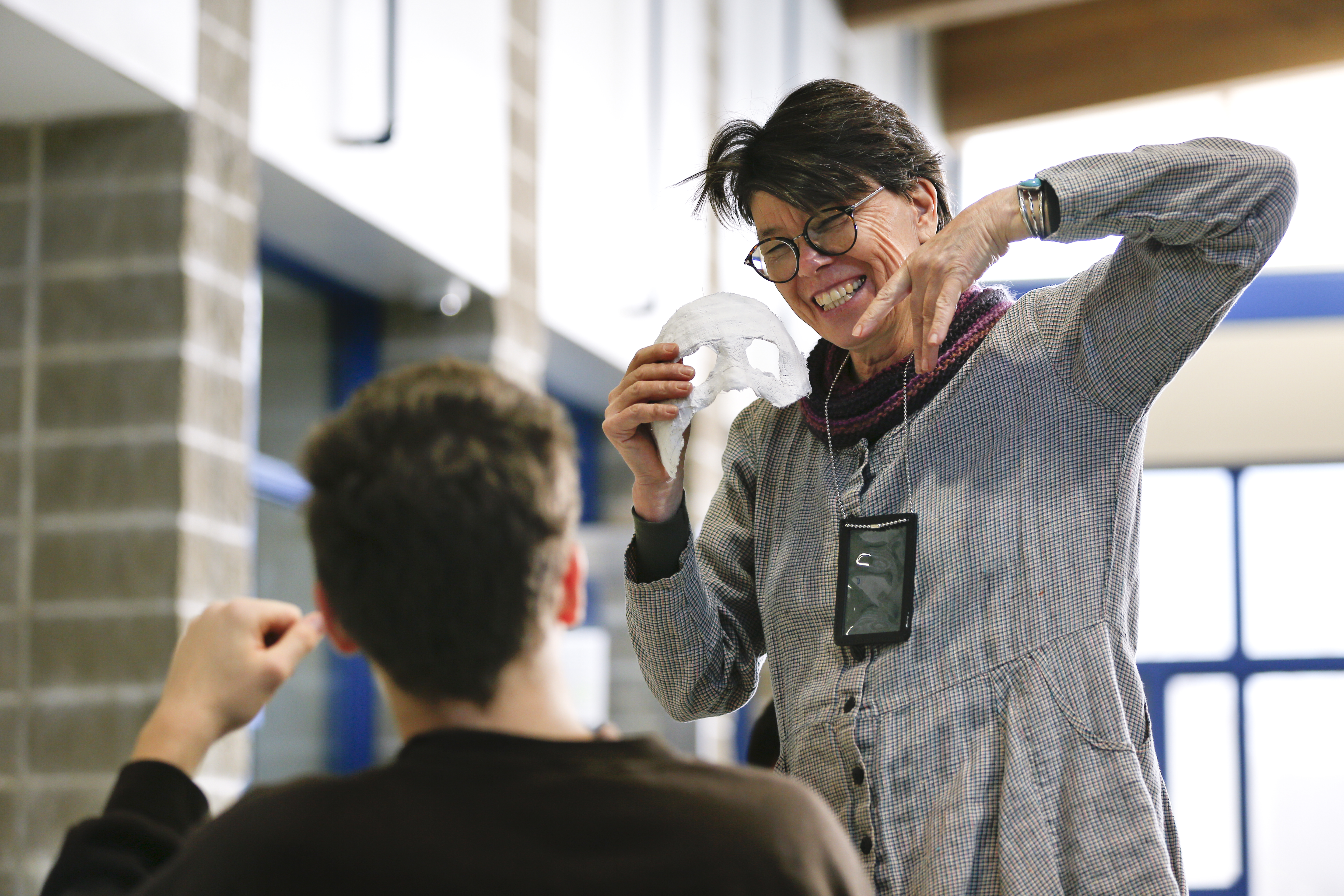Life lessons
Artist teaches incarcerated youths to help them get positive attention

Animated in her attempt, Laura Ramberg tries to give helpful instruction to a student designing a mask during an art session Feb. 1 at the Juvenile Detention Center, 330 NE Industrial Lane. Ramberg has been teaching at classes at the Juvenile Detention Center for the last 15 years.

A 16-year-old female student displays a mask she created Feb. 1 during an art session at the Douglas County Juvenile Detention Center, 330 NE Industrial Lane. Every Friday for the last 15 years, artist Laura Ramberg has been teaching art to youths in the facility. “I want to help them find their voice and find ways to use it constructively,” she says.
Every Friday for the past 15 years, artist Laura Ramberg has been teaching art to people convicted of some very serious crimes: Battery. Breaking and entering. Drug use.
None of her students are older than 17. Some are as young as 10.
Longer than many of her students have been alive, Ramberg has been leading classes for youngsters incarcerated at the Douglas County Juvenile Detention Center.
“I want to help them find their voice and find ways to use it constructively,” she says.
Ramberg teaches students who have been convicted of more serious crimes, along with a second class, often including youngsters with truancy issues who do not reside in the facility but have been ordered to attend day school at the site. The youths’ sentences can range from a matter of weeks to months, and many of them have been in and out of the facility multiple times.
Students’ past behaviors don’t concern Ramberg.
“These kids are so used to getting attention for their negative behaviors,” she says. “I want to them to learn how to get attention for positive things they do.”
And Ramberg has been helping them get that attention, providing opportunities for personal expression both in and out of the classroom. Last month she organized a show that included the students’ work at the Lawrence Percolator.
“It was about baggage and letting go of it,” she says. “I planned for it to coincide with the new year.”
Not only does Ramberg want her students to gain skills but also to live a more creative life. So she introduces them to a diverse range of activities including ceramics, origami, drawing and painting.
Her lessons frequently go beyond the visual arts.
Over the years she has invited others to share their expertise, including writers, musicians, and even R&B/Americana musician Kelley Hunt, who talked about singing and songwriting.
“No one has told me what art is, so I have a big curriculum,” she says.
Ramberg understands that the most valuable activities are those that encompass a range of objectives.
“I like to include history, multicultural experiences, art techniques and skills,” she says. “The best lessons contain life lessons and living skills.”
Take, for example, the lesson she created around boomerangs.
“We studied aboriginal art and abstract designs, and then we talked about energy, and how boomerangs come back to you,” Ramberg says. “It’s just like the energy you put out in life — whatever you put out will come back to you. Put out positive things, you get positive things.”
A more recent activity focused on masks and the disguises individuals use to project themselves to the world.
After creating plaster casts of their faces the first week, the students returned to complete them.
“It was crazy. We got slimed with Vaseline,” says a 13-year-old day-school participant, referring to the treatment he received prior to the application of the plaster strips.
A week later, the student, who says he likes art because it is the one subject that “doesn’t hurt his brain,” was painting his mask blue and white and adorning it with feathers.
After Ramberg instructed the students to create a character, several of the males created pieces that, perhaps, projected their personal dreams of a future beyond the detention facility: a Baltimore Ravens football player, a Jayhawk basketball star and a Free State Firebird.
Other students had a less literal interpretation of the assignment. One 16-year-old used his mask to illustrate transformations.
“The mask represents losing humanity, like the mask is consuming the face,” he says.
Another 16-year-old male, who has been in and out of the detention facility for several years, used his mask to convey a different message. After covering the surface with black tempera paint, he painted a large crack on it that tore through the top of the forehead.
“The crack represents the bad stuff that can happen and all of the things that can get you down — like being in here,” he says. “But I want to tell people not to let life get you down. Stay positive.”
“I know I don’t reach every kid every class,” Ramberg says, “but I do reach some.”
A 17-year-old who was sent to the correctional facility several months ago after some “problems with his girlfriend” is one of those who appreciate the class.
“I like Laura, and I like art because it is the perfect time to focus on myself,” he says. “Before, I worried too much about other people, but I am motivated to get out of here so I can go to college and study nursing. Also, I am the man of the house, so I want to get back home for my mom and my brother.”
Ramberg wants her students to know that they have choices.
“Their choices have gotten them into trouble in the outside world,” she says. But when it comes to art class, choices are all about artistic expression, which is what helps them find their voice.
“Art develops tools for negotiating a creative life,” Ramberg says. “Creative thinking does more than open doors, it creates doors.”







